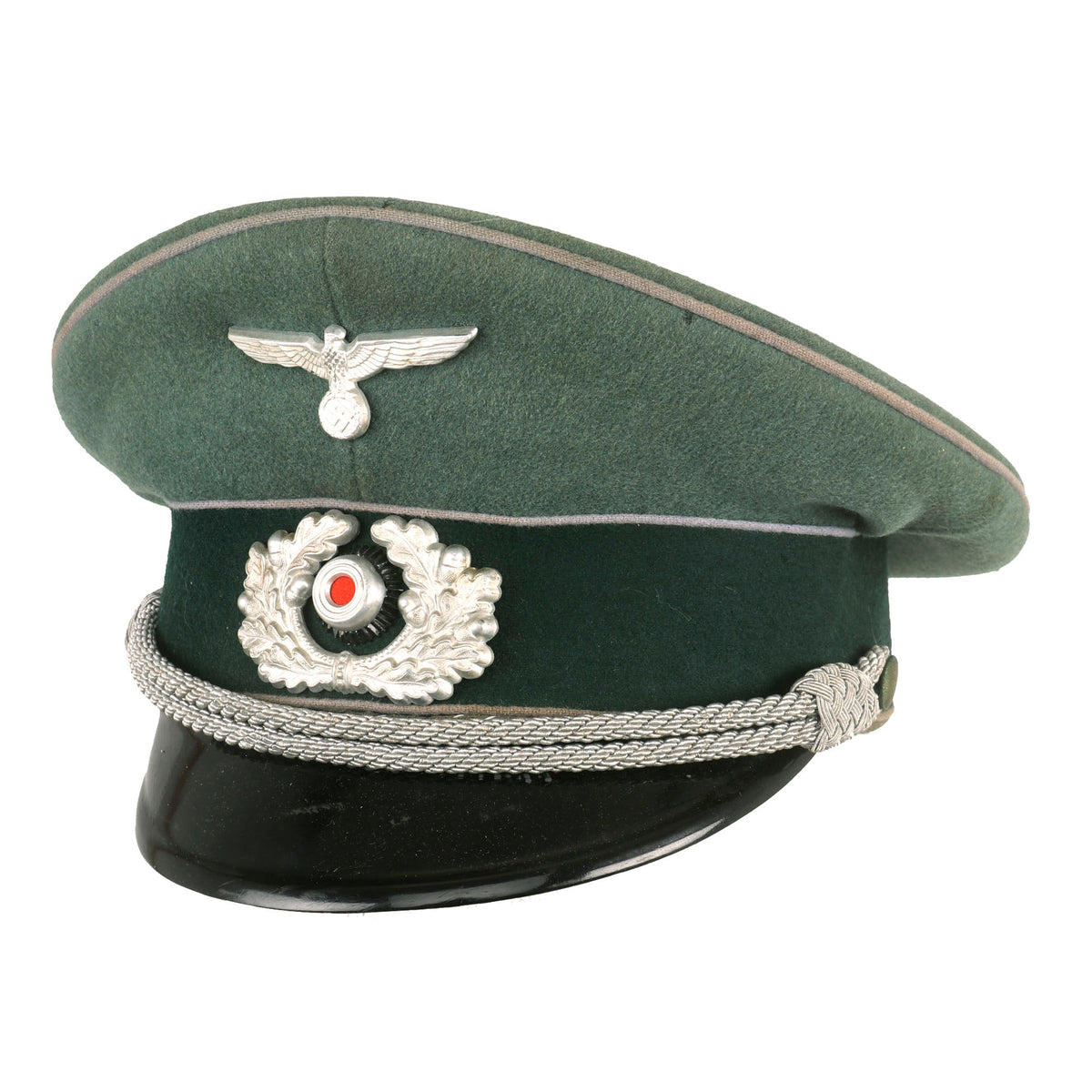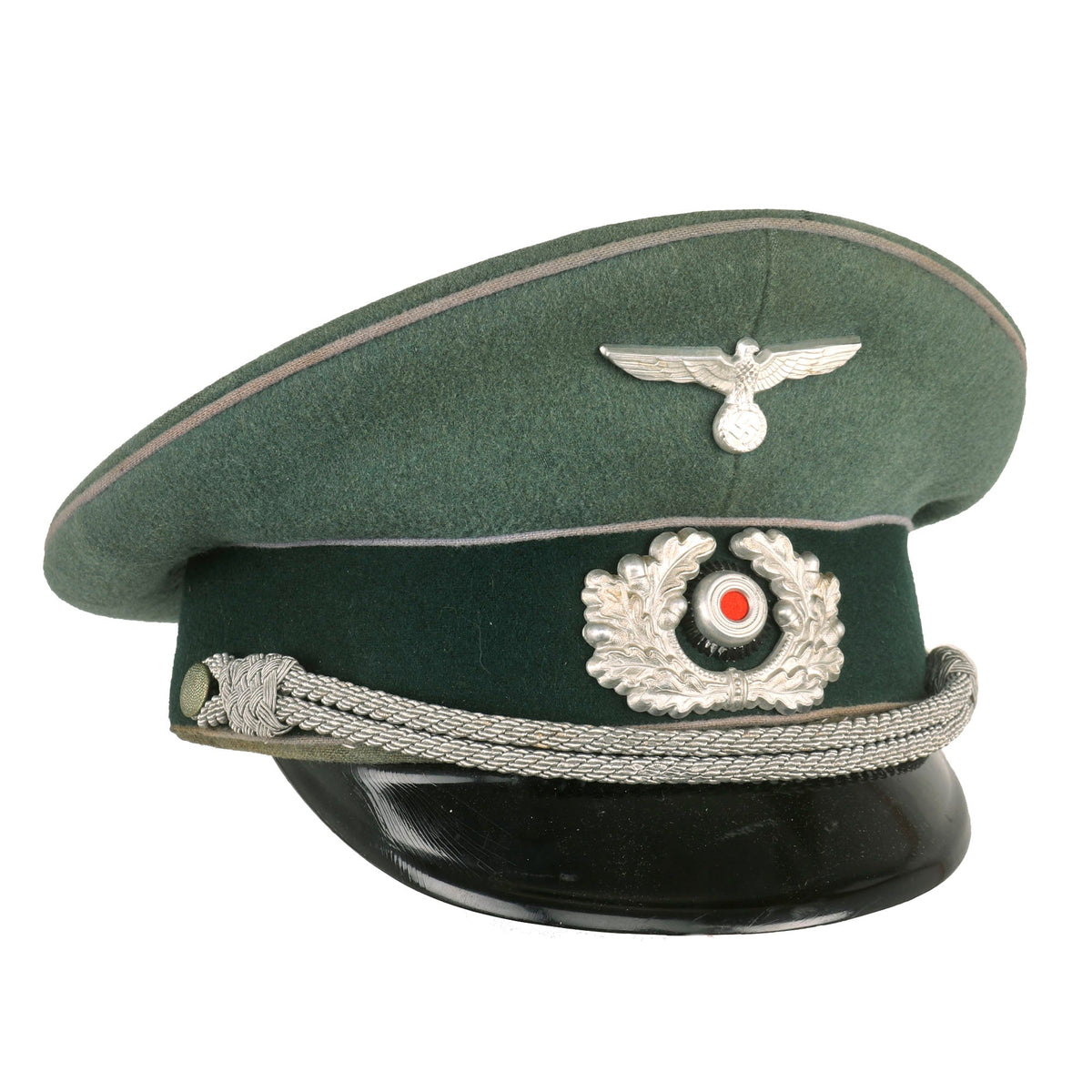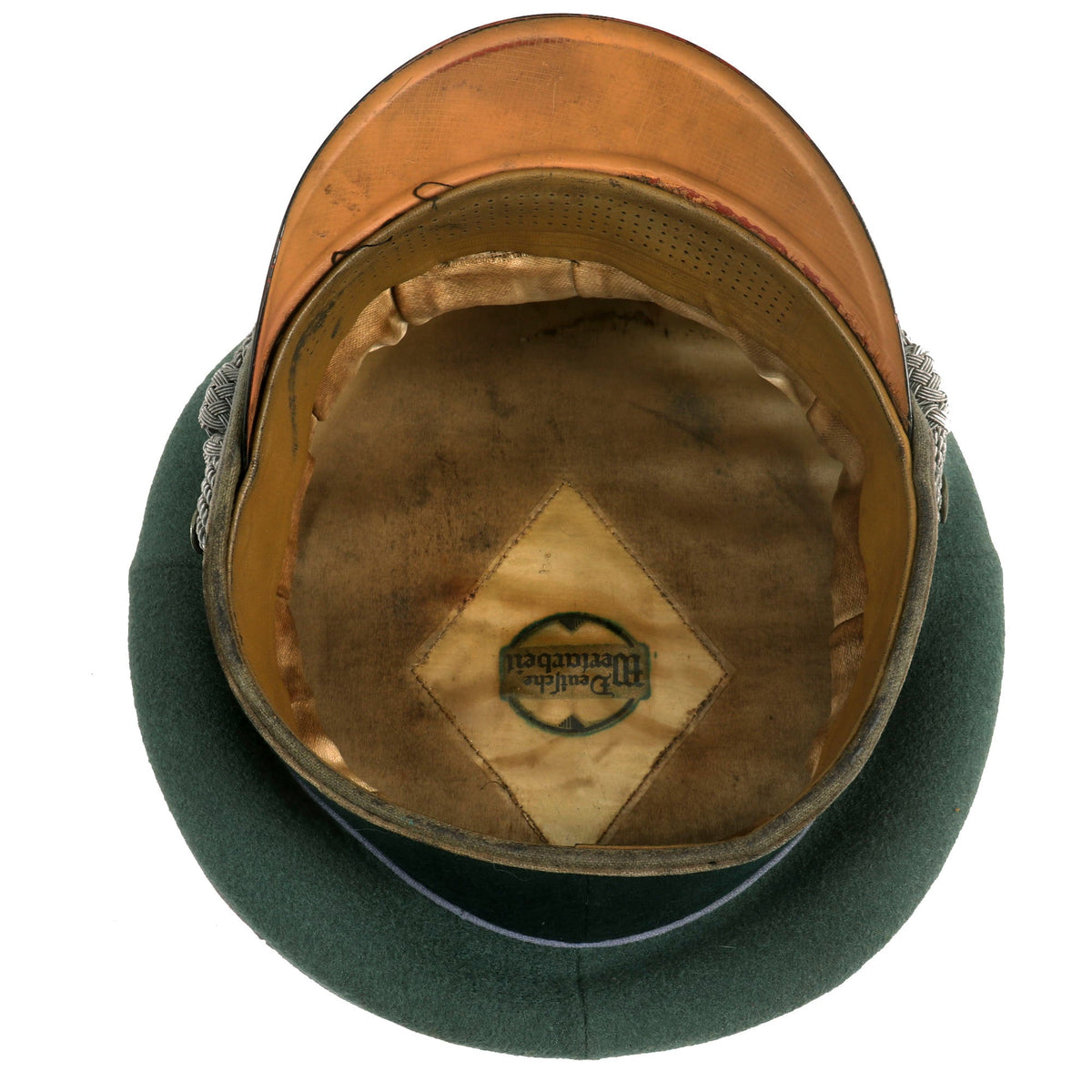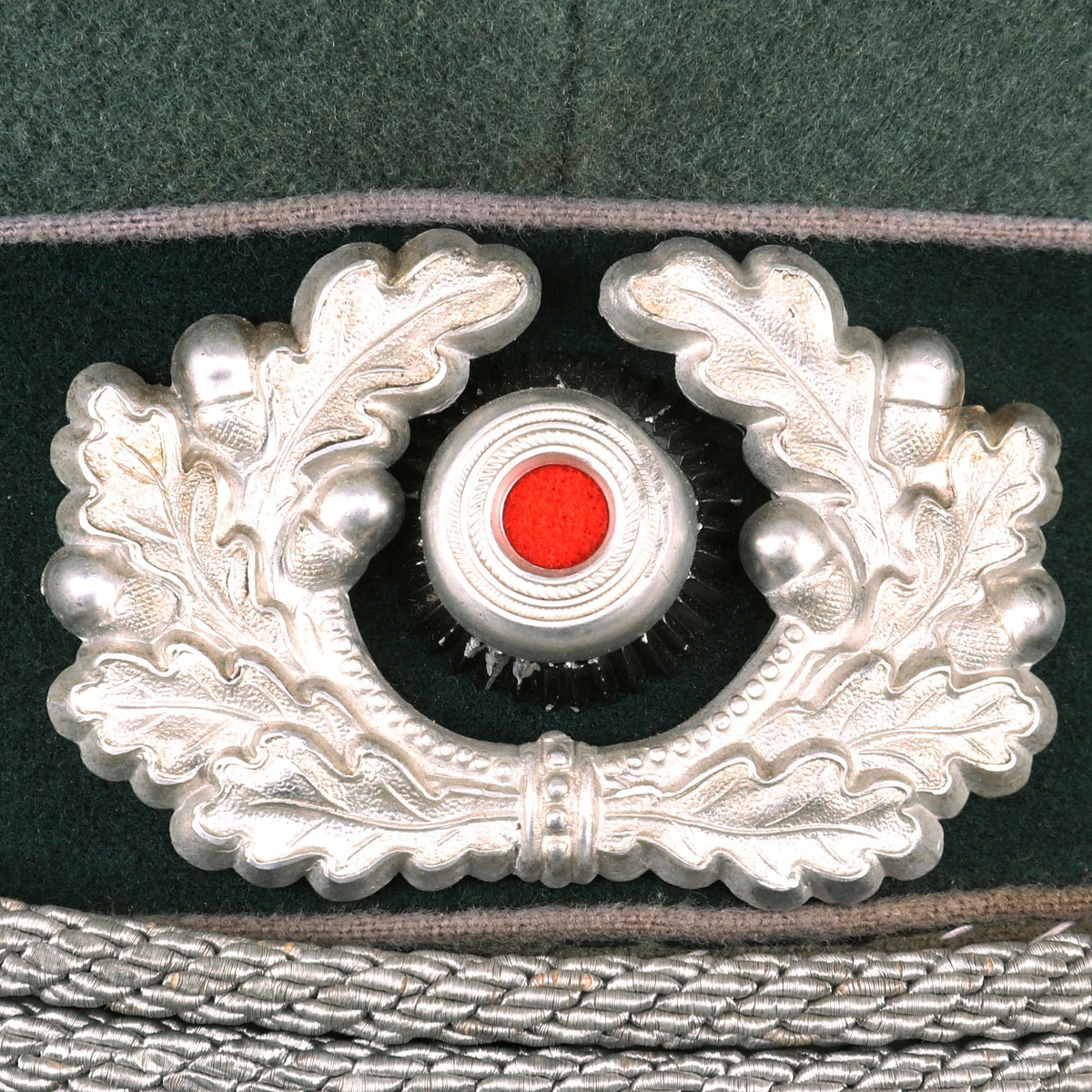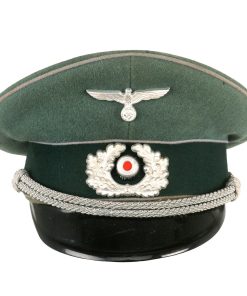Original German WWII Army Heer Transport and Supply Troop Officers Schirmmütze Visor Cap Original Items
$ 895,00 $ 223,75
Original Item: Only One Available. This cap is a very good service used example of a German WWII Wehrmacht Heer Army Infantry Officer’s Schirmmütze (visor cap), and it really looks the business. It still has the original crown stiffener installed, so the sides have not sunken down much over the years, giving it a lovely swept back look. It features the typical feldgrau (field gray) “doeskin” wool construction with a flaschengrün (dark bottle-green) “badge cloth” band and a traditional high forward crown. The cap also has matching Hellblau (Light blue) piping along the top edge and flanking either side of the band, the Corps Color (Waffenfarbe) for Transportation troops (Fahrtruppen) until 1942 and Supply troops (Nachschubtruppen) from 1942 onwards.
The piping has faded a bit towards purple, and does look a bit like the grau-blau (gray blue) used by Sonderführer Specialist Leaders, who were civilians with military rank, however they also tended to use a charcoal gray cap band, not the bottle green this example has. The piping under the crown is still the original light blue color.
It is decorated with a well detailed aluminum eagle insignia on the peak and and an open cast aluminum oak leaf and acorn wreath with an attached metal tri-color cockade on the band. The insignia are all still bright, showing only minor wear and oxidation, and the red felt insert inside the cockade is present and still vibrant. The chin strap is attached with the standard pebbled buttons on either side of the cap. The vulcanfibre visor has a smooth black leather-look upper, exhibiting minimal wear along the edge and is beige on the underside. The top shows a lovely pattern of very fine checking and crazing to the gloss enamel finish, and there is some wear from the chinstrap.
The inside of the cap is lined with cream rayon, which definitely shows some staining and wear overall, so the original color is only preserved under the fully intact sweat shield diamond. This has a logo on it that reads Deutsche Wertarbeit (German Workmanship), but there are no other markings on the interior of the cap.
The sweatband in this cap is made from genuine leather, which is finished in beige and is still quite supple, without any tearing or other major damage. There is some light staining, especially towards the front, and the stitching along the forehead area has rotted out over the years. The size seems to be about a 58cm.
Overall condition is very good, with a lovely “been there” look that cannot be duplicated. The colors are relatively well retained, though there is fading on the top of the crown and also on the piping. There are also some small moth nips on the exterior crown. The very bottom of the cap shows staining from sweat and oil, as is often seen. We can also see some white stitching around the visor area, used to reattach the visor to the body of the cap.
A lovely service used example of a classic hat worn by German Army Supply Officers in WWII. Very impressive and ready to display!
The German Schirmmütze Visor Cap:
The visor cap (Schirmmütze) was an important part of the headgear worn by German uniformed military, civil, paramilitary and political organizations during the Third Reich. This was the standard cloth headgear worn as a part of the service uniform. Visor caps were worn outdoors as well as indoors, and were often required to be worn by all personnel on duty. Visor caps were made in versions specific to each organization and were often further differentiated through the use of insignia, colored piping, or style of chin cord, to indicate rank, role or branch. The insignia used on these caps ranged from simple stamped metal emblems, to elaborate hand embroidery. Visor caps were issued to enlisted soldiers and NCOs in the military and in some other organizations. Officers had to purchase their own hats, and lower ranks could choose to purchase caps that were of a higher quality than the rather basic, issue examples. The private purchase caps were generally made in very high quality, with fine materials. A wide variety of fabrics were used, from Trikot and doeskin, to heavy wool, or even lightweight white fabric for summer wear. In the military, issue of these caps was generally suspended shortly after the outbreak of the war, but they continued to be worn by some troops until the end of the war.
Fast Shipping with Professional Packaging
Thanks to our longstanding association with UPS FedEx DHL, and other major international carriers, we are able to provide a range of shipping options. Our warehouse staff is expertly trained and will wrap your products according to our exact and precise specifications. Prior to shipping, your goods will be thoroughly examined and securely secured. We ship to thousands clients each day across multiple countries. This shows how we're dedicated to be the largest retailer on the internet. Warehouses and distribution centres can be located throughout Europe as well as the USA.
Note: Orders with more than one item will be assigned a processing date depending on the item.
Before shipping before shipping, we'll conduct a thorough inspection of the items you have ordered. Today, the majority of orders will be delivered within 48 hours. The delivery time will be between 3-7 days.
Returns
The stock is dynamic and we cannot completely manage it because multiple stakeholders are involved, including our factory and warehouse. So the actual stock may alter at any time. It's possible that you may not receive your order once the order has been made.
Our policy is valid for a period of 30 days. If you don't receive the product within 30 days, we are not able to issue a refund or an exchange.
You can only return an item if it is unused and in the same state as the day you received it. You must have the item in its original packaging.
Related products
Uncategorized
Armored Burgonet Helmet & Polearm from Scottish Castle Leith Hall Circa 1700 Original Items
Uncategorized
Uncategorized
Armoured Fighting Vehicles of the World: AFVs of World War One (Hardcover Book) New Made Items
Uncategorized
Uncategorized
Uncategorized
Uncategorized
Uncategorized
Uncategorized
Angolan Rebel 1970s era 60mm Inert Display Mortar from Angolan Civil War Original Items
Uncategorized
Uncategorized
Uncategorized
Uncategorized
Uncategorized
Uncategorized

